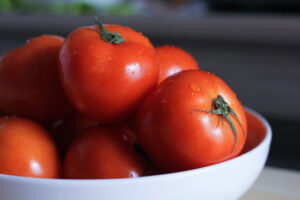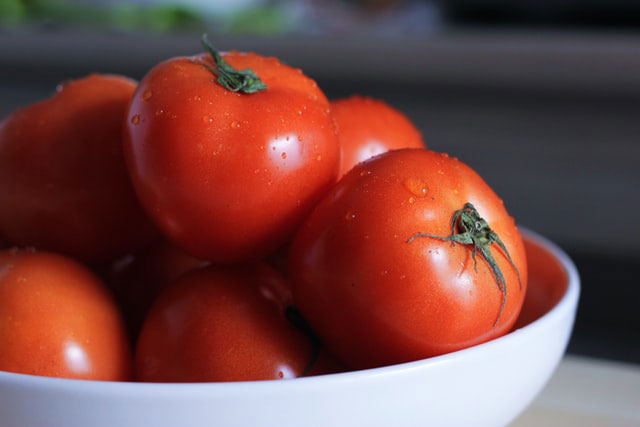In this and future posts I’ll be sharing a few seminal moments in my education as a cook; moments when I could feel my pupils dilate with excitement at what I had learned. I knew my cooking had just been irrevocably altered for the better. One of these times was when I learned about the concept of umami as the 5th flavor. I have since considered the quality and flavor of umami in most dishes I have cooked since this moment.
 “Umami (/uːˈmɑːmi/, from Japanese: 旨味 [ɯmami]) or savory taste is one of the five basic tastes (together with sweetness, sourness, bitterness, and saltiness). It has been described as savory and is characteristic of broths and cooked meats.”
“Umami (/uːˈmɑːmi/, from Japanese: 旨味 [ɯmami]) or savory taste is one of the five basic tastes (together with sweetness, sourness, bitterness, and saltiness). It has been described as savory and is characteristic of broths and cooked meats.”
You may think umami is some mysterious, hard to find, flavor. However, chemically, umami is simply gluatamate, or glutamic acid, an amino acid found in some animal proteins and plants. The flavor has actually been important to the survival of our species, because it signals the presence of important proteins in the diet. Our human tongues dedicate a large central section to detecting this flavor, and it is described as pleasant or “meaty”. We know it well and are drawn to it.
 Every culture has their list of foods that contain the flavor and character of umami. If your Thai, Mexican or Chinese soups, stirfry, or beans taste lifeless, bland, thin, lacking brightness and depth, consider additions of foods specific to that ethnic cooking. Here are some examples.
Every culture has their list of foods that contain the flavor and character of umami. If your Thai, Mexican or Chinese soups, stirfry, or beans taste lifeless, bland, thin, lacking brightness and depth, consider additions of foods specific to that ethnic cooking. Here are some examples.
- All meats and their stocks contain glutamates and therefore umami
- Seaweeds, especially Kombu. Throw a 3” piece into your soup stocks.
- Soy sauce
- Miso – a very healthy fermented product which is grown on soy, barley, or rice. Very salty! Very satisfying.
- Aged Cheeses – parmesan is a great example
- Kimchi – A Korean spicy, fermented cabbage condiment with powerful flavor.
- Green Tea
- Seafoods: Fish sauce, bonito flakes, anchovies are important sources of umami. They can be added in small amounts for big non-fishy flavor
- Tomatoes, especially dried because it concentrates the glutamic acid, translating to huge flavor boosts
- Mushrooms, like shiitake (again, the dried is more concentrated in flavor), and regular button mushrooms all add umami. Adding dried mushrooms to your soup stock adds lots of depth
- Green peas!
- Garlic
- Oyster sauce
- Corn
- Marmite
- Roasting vegetables to a caramelized state adds great depth of flavor and sweetness.
How to use these foods:
 “Start low, go slow” is an important adage here, especially with foods like miso, anchovies or anchovy paste, fish sauce, etc. Start with just a teaspoon stirred in, then taste, taste, taste! Add a teaspoon at a time until you sense the flavor bloom. Cooked, roasted, sautéed garlic will mellow its flavor but add complexity that you wouldn’t be able to label “garlicky”.
“Start low, go slow” is an important adage here, especially with foods like miso, anchovies or anchovy paste, fish sauce, etc. Start with just a teaspoon stirred in, then taste, taste, taste! Add a teaspoon at a time until you sense the flavor bloom. Cooked, roasted, sautéed garlic will mellow its flavor but add complexity that you wouldn’t be able to label “garlicky”.
The following paragraph from The New Yorker shows that umami is a quality worth cultivating in your dishes, not just for the depth of flavor, but also for the easy digestion that follows. If it’s important enough to have a competition among restauranteurs you know we small fry cooks might consider its importance. If it eases digestion it’s necessarily good for your overall health, too.
“When I asked him (Kazu Katoh, the winner of the Umami Restaurant Competition) to describe what umami tastes like, he grew philosophical. “It’s something that’s kind to the body,” he said. “It’s mild, and, after eating, it’s not heavy on your stomach. It helps you wake up better in the morning. That’s what deliciousness is about. It’s about feeling good after eating.” The most balanced meals, he said, have the same level of saltiness as exists naturally in our bodies, and umami in other countries can be too heavy on the stomach. “In Japan, we talk about it tasting good, sleeping well, and clean bowel movements. It has to do with the entire digestive process.”
The New Yorker
You Think You Know Umami
March 19, 2015

